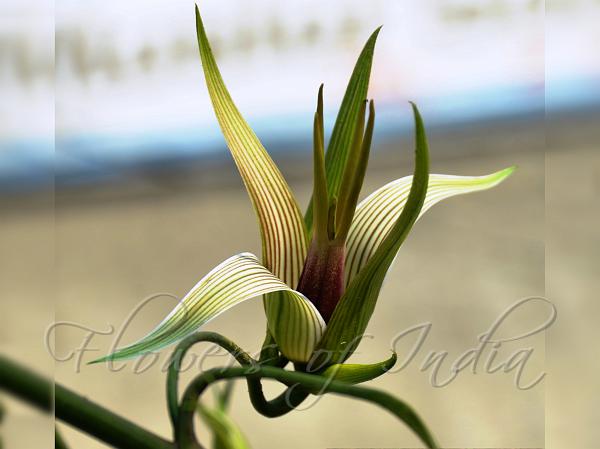|
| Wild Asparagus |
|

|

| File size | 439699 |
| Original date | 4/1/12 12:11 PM |
| Resolution | 2048 x 1536 |
| Flash | Flash did not fire, auto |
| Focal length | 105.0mm |
| Exposure time | 1/200s |
| Aperture | 8.0 |
| Focus Distance | |
| Metering Mode | Multi-segment |
| Camera make | NIKON CORPORATION |
| Camera model | NIKON D7000 |
| Sensor type | OneChipColorArea |
|
|
|
|
Photo: |
Botanical name: Stemona tuberosa Family: Stemonaceae (Stemona family)
Wild Asparagus is a vine 3-6 m long, stems often
branched, base woody. Leaves are opposite or whorled, rarely alternate;
leaf-stalk 3-10 cm; leaf blade ovate to ovate-lanceshaped, 6-24 x 5-17
cm, membranous, veins 7-13, base heart-shaped, margin slightly wavy,
tip tapering. Flowers are borne in 1-3-flowered clusters;
flower-cluster-stalk or flower-stalk in leaf-axils or rarely borne on
leaf-stalk, 2.5-5 cm; bracts lanceshaped, 5-10 mm. Tepals are greenish
with purplish veins, 3.5-7.5 x 0.7-1 cm, tip tapering. Stamens are
purple, slightly shorter than perianth; filaments stout, 2-5 mm;
anthers linear, about 1 cm; appendages partially adherent, upper one
about 5 mm. Capsules are ovoid-oblong, 2.5-6 x 1-3 cm. Wild Asparagus
is found in NE India to China and SE Asia, at altitudes of 300--2300
m. Flowering: April-July.
Medicinal uses: Roots are antibacterial, used
in curing for tuberculosis in lungs, soothes in human respiratory tract
and as antiseptic, and gynecological disorders. In China and Japan,
tubers are used in traditional Chinese and Japanese medicines for
centuries to manage respiratory diseases e.g. bronchitis, pertussis and
tuberculosis, and to prevent human cattle parasites, agriculture pests
and domestic insects. Tubers are also used in Bangladesh for mental
disorder, worm, cough and jaundice. Leaves are also used in night
blindness.
Roots are antibacterial, used
in curing for tuberculosis in lungs, soothes in human respiratory tract
and as antiseptic, and gynecological disorders. In China and Japan,
tubers are used in traditional Chinese and Japanese medicines for
centuries to manage respiratory diseases e.g. bronchitis, pertussis and
tuberculosis, and to prevent human cattle parasites, agriculture pests
and domestic insects. Tubers are also used in Bangladesh for mental
disorder, worm, cough and jaundice. Leaves are also used in night
blindness.
Medicinal uses:
 Roots are antibacterial, used
in curing for tuberculosis in lungs, soothes in human respiratory tract
and as antiseptic, and gynecological disorders. In China and Japan,
tubers are used in traditional Chinese and Japanese medicines for
centuries to manage respiratory diseases e.g. bronchitis, pertussis and
tuberculosis, and to prevent human cattle parasites, agriculture pests
and domestic insects. Tubers are also used in Bangladesh for mental
disorder, worm, cough and jaundice. Leaves are also used in night
blindness.
Roots are antibacterial, used
in curing for tuberculosis in lungs, soothes in human respiratory tract
and as antiseptic, and gynecological disorders. In China and Japan,
tubers are used in traditional Chinese and Japanese medicines for
centuries to manage respiratory diseases e.g. bronchitis, pertussis and
tuberculosis, and to prevent human cattle parasites, agriculture pests
and domestic insects. Tubers are also used in Bangladesh for mental
disorder, worm, cough and jaundice. Leaves are also used in night
blindness. | Identification credit: M. Sawmliana | Photographed in Seling area, Mizoram. |
• Is this flower misidentified? If yes,